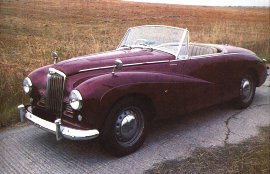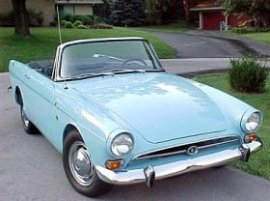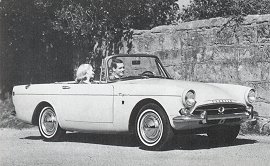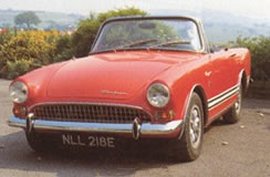
The first Alpine would be released in 1953, based
on the chassis and running gear of the
Sunbeam-Talbot 90 saloon...

Despite the ‘new’ Alpine only having
a 1494cc 4 cylinder engine, it came tantalizing
close to cracking the holy grail of 100mph...

This publicity shot would have been much better
if it featured agents 86 and 99...

You have to look closely to spot the differences
between the Alpine and the Tiger, the Ford 4.2
litre V8 fitting into the engine bay without external
sheet metal modification...

Less noticeable when the car is in profile, the
Alpine and Tiger featured a prominent "tail
fin" design... |
“Fill up the Sunbeam”, mention this in
an Australian home today and most would assume you are
talking of the kettle. But there was a time when the
word Sunbeam would evoke the very essence of automotive
fervor.
Until the mid 1920s Sunbeam were one of the
very few British companies to seriously build, develop
and race a team of Grand Prix cars. And in 1923 Sunbeam
would taste success with Sir Henry Segrave taking out
the French Grand Prix, making for a British Driver/Manufacturer
combination that would not be repeated until the 1950’s.
Sunbeams had developed an enviable reputation during
the first quarter of last century, but there was a vast
chasm between the passenger conveyances and grand prix
cars being produced, and there was certainly no sports
type car for the young at heart. With Sunbeam becoming
part of the STD (Sunbeam- Talbot-Darracq) combine, the
marque set its sights on Le Mans, and on the very competitive
Bentleys.
In 1925 Sunbeam developed a 3 litre model, sized appropriately
to compete with the 3 litre Bentley that had won the
previous years Le Mans event. The Sunbeam 3 litre was
fitted with an engine based on those used in the Grand
Prix events, featuring twin overhead cams, driven by
gears, while the camshaft and crankshaft were superimposed
in seven main bearings.
The car was lubricated by dry
sump, and used twin Claudel-Hobson carburettors; the
engine was in turn mated to a four-speed close-ratio
gearbox.
A peculiarity of the four-seater open 3 litre was that
it had close-fitting cycle type front wings, which turned
with the wheels.
But the car did not perform to expectations,
the chassis often being singled out for criticism due
to its overly complex design and, it seemed, engineered
frailty. Only 250 were produced before manufacture ceased
in 1930 - perhaps if there had been a more rigid short-chassis
type Sunbeam might have sold more!
The company finally
went into liquidation in 1935 as the STD combine collapsed
from the top. The Wolverhampton based Sunbeam company
was eventually taken over by the Rootes Group, along
with its sister company Talbot, where both would join
the Hillman and Humber marques.
The marque was not resurrected in a sports car sense
until 1953 when the wonderful new two-seater “Alpine”
was announced. The Alpine was based on the chassis and
running gear of the Sunbeam-Talbot 90 saloon, and as
such was in reality an entirely Rootes affair. To address
scuttle-shake the frame was stiffened up with extra
side plates, and the nose of the car was exactly like
that of the saloon.
The Alpine featured independent
front suspension by coil springs and wishbones; at the
rear a rigid axle was located by half-elliptic leaf
springs. The four-cylinder 2267cc engine developed 80bhp at
4200rpm, power being delivered to the rear wheels via
a four-speed gearbox with the shifter located, as was
the fashion of the day, on the steering column.
Many
would remember the Aussie “Three-on-the-Tree”,
a three speed ‘sludge box’ setup designed
to allow three people to sit in the front seat, but
one must question the benefit of such a design being
used in the Alpine when the front seat contours made
it impossible for more than two to be seated!
Nevertheless the Alpine was soon enjoying success in
competitions such as at the Coupes de Alpes Alpine Rally,
where the team cars won four separate events. Then Stirling Moss would use Alpines in 1953 and 1954 to become only
the second driver in history to win a Coupe d'Or for
three consecutive 'clean' runs on this difficult event.
But after two short years the Alpine was discontinued
in 1955, but just why the powers to be at the Rootes
group came to this decision we remain unable to fathom.
One possible explanation is that Rootes had been busy
developing the Sunbeam “Rapier”, and thought
the marque required only one “hero car”.
In what can best be described as a public relations
disaster, the Rapier name would be dropped in favour
of Alpine in 1959.
The new car could best be described
as a “bitsa”, using the Rapier Series III
running gear and suspension, fitted to a shortened version
of the under-pan, all draped in a lovely two-seater
body she with prominent tail fins.
Despite the ‘new’ Alpine only having a
1494cc 4 cylinder engine it came tantalizing close to
cracking the holy grail of 100mph (161 kmh), on the
down side was the fact that it took a leisurely 13 seconds
to reach 60mph from rest. With a smaller engine capacity
than its main rivals, such as the MGA/MGB and Triumph
TR series, the Alpine was invariably overshadowed and
often overlooked. What a shame though, for the styling
was and remains worthy of earning the car a much greater
place in automotive history.
The Alpine would enjoy a reasonably long life-span,
built from 1959 to 1968 and growing up to Series V which
was fitted with a 1725cc engine. The purchaser could
option the “overdrive” transmission, and
there was even a short run of Automatics built. And,
to help make the Alpine more appealing to a broader
motoring public, it could be ordered in either open
sports or closed hardtop versions.
There were also a
few fastback conversions manufactured, with Rootes approval,
by Harrington of Sussex. This type of Alpine had a limited,
but creditable, competitions career, which included
winning the Index of Thermal Efficiency award at Le
Mans on the first of three visits in 1961.
But there were those that lamented the Alpines lack
of power. Ian Garrad was one such person; the son of
then competitions manager Norman Garrad, Ian was the
Rootes company’s Californian representative -
and was well aware of the way that Carroll
Shelby had
transformed the AC Ace into the Cobra with a Ford V8
engine transplant.
Garrad enlisted the help of Ken Miles,
and together they effected a similar transplant to that
of the AC. Their choice of engine was the Ford 4.2 litre
164bhp unit, and they then shipped their “prototype”
back to the UK headquarters. The Rootes management were
impressed, and well should they have been – for
the choice of engine meant there were absolutely no
visual outer skin panel changes required to fit the
lusty V8 engine!
The modified Alpine was dubbed the Sunbeam “Tiger”,
and assembly moved to Jensen at West Bromwich. The engineers
soon discovered just how well sorted the Alpine was,
finding the body well able to handle the huge increase
in torque. Naturally the Tigers performance humbled
the Alpine. The 0-60mph dash was down to a very respectful
9.5 seconds, while the car was good for a top speed
of 118mph (190 kmh).
The factory made one attempt race the Tiger –
at the 1964 Le Mans – but both cars that were
entered retired early with engine failures. Nevertheless
others thought the car had rally potential. One was
entered by privateer Peter Harper's in the 1965 Monte
Carlo Rally, but as luck would have it his sixth placing
was disqualified after scrutinizers found illegal technical
modifications had been made to the car.
In 1967 the 4.7 litre series 2 Tiger would be released,
but shortly afterward Chrysler would acquire the Rootes
group and the new management would choose to bring production
to a premature end. Most commentators of the day acknowledged
the takeover of Rootes by Chrysler would always be the
downfall of the Tiger, simply put it would be somewhat
embarrassing for Chrysler to manufacture a car and install
a Ford engine!
Also see: Sunbeam Car Reviews | The History of Sunbeam Motor Co. (USA Edition) |



